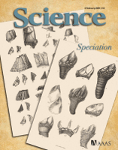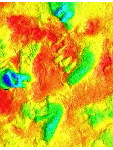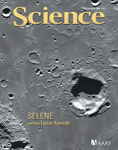 Diversification
and Speciation
Diversification
and Speciation
Special Online
Collection
In the 6 Feb 2009 issue, Science
continued its celebration of the 200th birthday of Charles Darwin. In a
special section on the speciation of living organisms, five Reviews
presented multiple views on diversification at scales ranging from the
macroevolutionary to the molecular. Topics included the extents to
which biotic and abiotic factors have shaped species diversity in the
fossil record, patterns of adaptive radiation, microbial species
formation, and predictive principles of genetic evolution. Elsewhere in
the magazine, the second in a series of monthly "origins" essays
discussed the origins of art and symbolic behavior (listen to the
related podcast
interview), the Commentary section featured reviews of new books
about evolution, an Editorial highlighted uncertainties in our
estimates of the world’s living species, and research papers covered
themes from mass extinction to conservation and hybrid sterility.
Online, Science Careers
offered a feature on researchers in the museum world, who play a vital
role in evolutionary research.
Color and Cognition
Color is a fundamental aspect of human perception, and its effects on
cognition and behavior have intrigued generations of researchers.
Previous research on how color affects cognition, however, has yielded
inconsistent findings. For example, some research suggests that red
enhances cognitive task performance as compared with blue or green,
while other studies suggest the opposite. In a Report in the 27 Feb
2008 Science (published
online 5 Feb), Mehta
and Zhu sought to reconcile this inconsistency (see the ScienceNOW story by G. Miller).
In a series of experiments, the researchers manipulated the background
color on a computer screen while volunteers performed a variety of
tasks. For those tasks that required attention to detail -- such as
recalling words from a list or proofreading addresses -- participants
performed better when the background was red, as opposed to blue or
neutral. Blue, on the other hand, stimulated creativity. When subjects
were asked to name as many uses for a brick as they could think of in a
minute, they came up with more creative responses and earned higher
creativity scores from a jury of their peers when the background was
blue. The researchers surmise that the results reflect the different
associations conjured by red and blue. Red often alerts us to danger or
mistakes, signaling the need to be vigilant. In contrast, blue is often
associated with peace and tranquility, which may put people in a more
creative mindset.
 Envy and Schadenfreude in
the Brain
Envy and Schadenfreude in
the Brain
Neurocientists have identified the neural systems responsible for
experiences of physical pain and pleasure. The pain network consists
primarily of the dorsal anterior cingulate cortex (dACC), insula, and
somatosensory cortex, whereas the reward or pleasure network consists
of the neural structures receiving the neurostransmitter dopamine from
the ventral tegmental area, including the ventral striatum,
ventromedial prefrontal cortex, and the amygdala. Now, in a Report in
the 13 Feb 2009 Science, Takahashi
et al. show that social pains and pleasures involve these same
circuitries. Using functional magnetic resonance imaging, the
researchers tracked the neural responses of healthy human subjects in
situations designed to invoke feelings of envy and schadenfreude
(pleasure from someone else’s misfortune). They found that envy
correlated with activation of the dACC, where physical pain and
cognitive conflicts are processed, and that stronger envy (felt when
the envied person had superior or more self-relevant characteristics)
induced stronger activation. In contrast, schadenfreude was associated
with activation of the ventral striatum, a central node of reward
processing, and activation of this region was more intense when
misfortune befell an envied person rather than a neutral person. An
accompanying Perspective
by M.D. Lieberman and N.I. Eisenberger noted that "[t]he link between
social and physical pains and pleasures adds to the growing chorus of
neurocognitive findings that point to the critical importance of the
social world for the surviving and thriving of humans."
Ancestral Viral Integration
Many species of parasitic wasp inject virus-like particles called
polydnaviruses (PDVs) into their caterpillar hosts, paralyzing host
defenses and allowing their own eggs to survive and develop. Curiously,
polydnavirus DNA encodes virtually none of the structural proteins
needed for viruses to replicate, raising questions about whether PDVs
are actually of viral origin. A Report in the 13 Feb 2009 Science now resolves this genetic
mystery. Bezier
et al. analyzed DNA derived from wasp ovaries, where PDVs are
produced, and identified 22 genes closely related to those of insect
viruses called nudiviruses -- a sister group of baculoviruses. These
genes encode subunits of a viral RNA polymerase and proteins involved
in polydnavirus particle assembly and packaging. Conservation of this
viral machinery in related wasp lineages suggests that nudiviruses
infected wasps a few million years ago and that, over time, the viral
DNA fully integrated into the wasp genome (see the related ScienceNOW story by R.
Zelkowitz). Today, the wasps and the polydnaviruses need each other to
survive. An accompanying Perspective
by D.B. Stolz and J.B. Whitfield noted that "there is now reason to
start thinking about virus-host relationships in much broader terms."
 Early Hominin Footprints
Early Hominin Footprints
The human foot -- composed of twenty-six bones held in a
three-dimensional latticework of ligaments and tendons -- is one of our
more distinctive adaptations. Preserved footprints can provide
important information about when and how our foot structure and bipedal
gait evolved, but research has been hampered by a scarcity of prints
and an inadequate hominin fossil record. Now, in a Report in the 27 Feb
2009 Science, Bennett
et al. report the discovery of a ~1.5 million-year-old fossil
footprint trail at Ileret, east of Lake Turkana in Kenya -- the oldest
attributable to our own genus, Homo.
Analysis of the footprint surfaces by laser scanning and geometric
morphometric statistical techniques reveal that the size of the Ileret
footprints is consistent with stature and body mass estimates for Homo ergaster/erectus, and that the
prints are morphologically distinct from the 3.75-million-year-old
footprints recovered 30 years ago from Laetoli, Tanzania and attributed
to Australopithecus afarensis.
The Ileret footprints show the hallmarks of a relatively modern
human-like foot including a medial arch, an adducted (in-line) big toe,
and evidence of the transfer of weight to the ball of the foot before
toe push-off. A related Perspective
by R. H. Crompton and T. C. Pataky commented that the new findings
"herald an exciting time for studies of the evolution of human gait."
Phytoplankton Trapping
Phytoplankton -- the microscopic photosynthetic organisms at the base
of oceanic food webs -- play a key role in the ecology of our planet.
Although many species are active swimmers, phytoplankton are also known
to aggregate into dense layers millimeters to meters in thickness that
can extend horizontally for kilometers below the ocean surface. The
concentrated plankton and detritus in these layers provide sustenance
for zooplankton and fish larvae, but they can also contain toxic
phytoplankton species that seed harmful algal blooms. In a Report in
the 20 Feb 2009 Science, Durham
et al. proposed a mechanism by which plankton layers form, which
they term "gyrotactic trapping." The team explains that many
phytoplankton species swim upward against gravity, but that this
migration can be disrupted by a discontinuity, or shear, in water flow.
They demonstrated that when the shear exceeds a critical value, the
cells’ orientation machinery fails, causing them to spin continuously.
Halted by this pattern of nondirectional movement, the plankton
accumulate in layers. Given the wide range of environments and species
associated with phytoplankton layers, it is unlikely that a single
mechanism is responsible for the formation of all layers. Nevertheless,
these results show that the microscopic coupling between microorganism
motility and ambient fluid motion can shape macroscopic features of the
marine ecological landscape. An accompanying Perspective
by D. Grünbaum highlighted the study.
Forming Oceanic Crust
Nearly two-thirds of Earth’s crust is formed at mid-ocean ridges. The
crust can be roughly dated using magnetic signatures (magnetic minerals
in the crust are magnetized in the direction of Earth’s magnetic field
as they cool and solidify), but details about the mechanism(s) of
crustal accretion have been difficult to discern. In the 20 Feb 2009 Science, Lissenberg
et al. reported that tiny zircon crystals that are relatively
abundant in the oceanic crust make it easy to date the crust, thereby
providing a clearer picture of the formation processes involved. The
team performed high-precision uranium-lead dating on zircon grains
found in rock layers on the mid-Atlantic ridge. Their data reveal a
systematic increase in zircon age away from the center of the ridge,
which indicates that the crust grew in a slow and regular pattern, at
least at that location. Each sample had single-grain zircon dates that
span 90,000 to 235,000 years, which the researchers interpret to
reflect the time scale of zircon crystallization and thus the cooling
rate of the crust. An accompanying Perspective
by P.J. Michael and M.J. Cheadle highlighted the Report, noting that
"[a]ccurate cooling rates will place constraints on how oceanic crust
grows and may even help to constrain how deep hydrothermal circulation
might go."
 SELENE and the Lunar
Farside
SELENE and the Lunar
Farside
The Moon is our closest planetary neighbor, but many questions about
its origin and early history remain unanswered. Particularly
confounding are the notable differences in crustal thickness and
density, composition, and volcanic activity between the Moon’s nearside
and its farside. In the 13 Feb 2009 issue, four Reports presented
observations from the Japanese Selenological and Engineering Explorer
(SELENE or Kaguya) mission that further our understanding of the Moon’s
evolution and, in particular, of its farside. Using data from a laser
altimeter on board the explorer, Araki
et al. derived a high-resolution lunar topographic map.
Spectral analysis of the topography indicates that the Moon has a dry,
rigid crust. Namiki
et al. provided an improved gravity map of the Moon, which
shows a marked difference between the nearside and farside. By
analyzing images taken by the SELENE Terrain Camera, Haruyama
et al. determined that volcanism on the lunar farside lasted about
500 millions years longer than previously thought. And Ono et
al. described subsurface stratifications on the lunar nearside,
which indicate a possible period of reduced volcanism in its early
history. G. A. Neumann and E. Mazarico discussed the findings in a
related Perspective
and podcast
interview.
From Greenhouse to Icehouse
For much of Earth’s history, the climate has been considerably warmer
than it is today. But about 34 million years ago, at the
Eocene-Oligocene transition, Earth’s climate underwent a dramatic shift
from a relatively ice-free world to one in which Antarctica became
buried beneath kilometers of ice. In a Report in the 27 Feb 2009 Science, Liu
et al. shed light on how Earth’s temperature changed during this
transition. Geochemical evidence of sea surface temperature changes at
ocean locations around the world indicate that mid-to-high-latitude
surface waters cooled from about 20 degrees to 15 degrees Celsius.
Although lower latitudes also experienced cooling, the effect was not
as significant. Combining these results with oxygen isotopic data --
which can be used to estimate ice volume as well as temperature --
indicates that the volume of continental ice varied only slightly
during the transition, and that contrary to a previous analysis,
glaciation of the Northern Hemisphere did not occur. An accompanying Perspective
by L. R. Kump considered how a reduction in atmospheric carbon dioxide
concentrations could explain the cooling patterns indicated by the new
temperature proxies.
A Better Barrier?
Plastics are versatile, easy to manufacture, and relatively
inexpensive, making them successful replacements for more traditional
materials such as glass, metals, and wood. In applications such as
packaging, however, molded plastics can be a disadvantage because they
are permeable to atmospheric gases -- a property that can compromise
the integrity of products from beer to intricate electronics. In a
Report in the 6 Feb 2009 Science,
Wang
et al. reported that a specialized crystallization process can
cause commonly used polymers to form so called polymer single crystals
that show a marked reduction in gas permeability. The researchers made
a series of polymer films through a multiple folding process generating
extremely thin, alternating layers of two different polymers:
polyethylene oxide or PEO -- a crystallizable polymer-- and
ethylene-co-acrylic acid. They found that confining the thickness to 20
nanometers, forces the long-chain molecules of PEO into their most
compact arrangement, that of large single crystals. The permeability of
PEO to oxygen decreased by about two orders of magnitude in this
crystalline form. The technique could thus aid the development of
improved protective films and packaging materials. An accompanying Perspective
by P.J. Lemstra highlighted the study.
New Route to Nanoelectronics
In the nascent days of the electronics industry, researchers would glue
materials together by hand to develop new device structures.
Electronics are growing ever smaller, however, and today it is possible
to sandwich oxide materials together with atomic-scale precision,
giving rise to insulating, metallic, and even superconducting behavior
at their interfaces. Until now, fabrication of such metal oxide devices
has required complex lithographic processes. Now, in a Research Article
in the 20 Feb 2009 Science, Cen
et al. have described a simpler approach. Using the tip of a
conducting atomic force microscope, the team was able to etch tiny
tunnel junctions and field-effect transistors -- as small as 2
nanometers across -- at the interface of lanthanum aluminate and
strontium titanate (a polar and nonpolar semiconducting oxide,
respectively). Moreover, these structures can be written and erased
hundreds of times simply by scanning with a negative voltage or by
illuminating with light. An accompanying Perspective
by Reiner et al. noted that "[a]s the relation between structure and
behavior is understood for more complicated materials systems, the
number of potential applications will increase dramatically." Possible
applications include environmental energy harvesting, thermoelectric
energy conversion, memory-storage devices, chemical sensors, and more
advanced logic circuits.
Brevia Highlights
The month in Science’s Brevia
section:
-- Mitrovica
et al. (6 Feb 2009) offered revised projections of sea-level rise
caused by melting of the West Antarctic Ice Sheet that indicate
accentuated rise in the oceans bordering North America and in the
Indian Ocean.
-- Stutchbury
et al. (13 Feb 2009) described how miniature recorders mounted on
purple martins and wood thrush allow mapping of bird migration routes
between North America and the Neotropics (see the related ScienceNOW story by J. Grom)
-- Evans
and Reimer (20 Feb 2009) analyzed how open access to scientific
research papers influences global participation in science and found
that making articles available free online increases the rate at which
they are cited, especially by authors in poorer countries.
-- Antonakis
and Dalgas (27 Feb 2009) found that voters in political elections
do not appropriately weight performance-based information on the
candidates, but rather seem to use the same cues that children use to
categorize individuals on competency.
In Science Signaling
ATP in the Immune System
Extracellular adenosine 5’-triphosphate (eATP) is widely used for
cell-to-cell communication. The low concentration of eATP that exists
in a "halo" surrounding resting cells signals the presence of
neighboring living cells. Transient increases are used for basic
physiological signaling in the nervous and vascular systems, whereas
larger increases in eATP that are associated with cell death serve as a
key "danger" signal in inflammatory processes. In a Perspective
in the 3 Feb 2009 issue, A. Trautmann highlighted two new studies
that point to roles for ATP in the immune system. One group found that
eATP provides a costimulatory signal to T cells to facilitate antigen
recognition; another reported that ATP released by commensal bacteria
drives the differentiation of intestinal T helper cells, which are
involved in mediating an inflammatory response against infectious
agents. The cellular networks responsible for these phenomena are still
to be discovered.
Also in Science Signaling
this month:
-- Kino
et al. found that the guanine nucleotide exchange factor Brx is
essential for osmotic stress–mediated expression of nfat5 (which encodes a key
regulator of osmotic response) in lymphocytes (10 Feb 2009)
-- Inoue
et al. showed that the cytoplasmic protein Dok-7 is required for
the full activation of the muscle-specific receptor tyrosine kinase
MuSK, which orchestrates the formation of neuromuscular junctions (24
Feb 2009)
-- Y.
Cao discussed the effects of placental growth factor (PlGF) and
VEGF-B, two vascular endothelial growth factors, on angiogenesis (24
Feb 2009)
This month’s Science Roundup is sponsored by
Qiagen
NEW:
QIAgility Rotor-Gene Q
Automated solutions for quantitative PCR
www.qiagen.com/goto/QIAgilityS
Image credits (in order of appearance): Science cover, 6
February 2009; Takahashi et al., Science 323, 937
(2009); Matthew Bennett/ Bournemouth University; Science cover,
13 February 2009.

